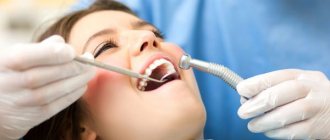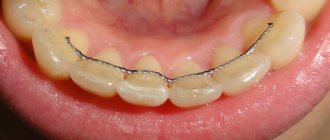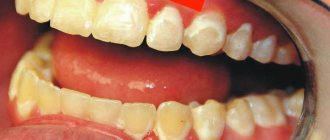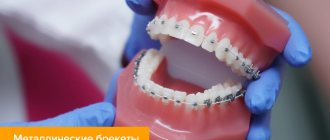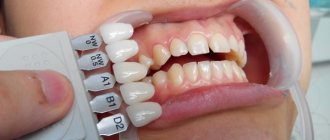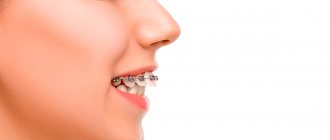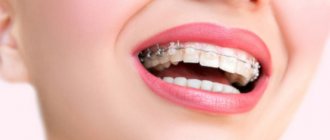Orthodontic treatment does not end when braces are removed. To maintain the results obtained by keeping the teeth in the correct position, patients have to wear a so-called retainer for some time. Today, there are various options for retention structures of removable and non-removable types, but due to the successful combination of functionality and cost, the most popular is the non-removable wire type. It is miniature in size and is attached to the lingual side of the teeth, remaining invisible to others. The type of retainer is chosen by the attending physician, depending on the clinical situation and the pathology of the bite.
Why are these structures installed?
Braces move teeth in the desired direction, but this effect is not limited to simple correction. This procedure is accompanied by the reconstruction of blood vessels and ligaments.
In the area where the tooth moves, bone tissue is absorbed, and in the opposite area, the process of its formation takes place.
And if muscles quickly adapt and change the principle of their work, then bone formation takes a long time . Therefore, the level of tooth mobility is maintained and auxiliary fixation is required until a layer of new tissue forms.
Retainers are installed to keep teeth from moving as the body gets used to the unusual position. This requires a lot of effort, therefore, the fastening device must be as rigid as possible.
Refusal to use special devices leads to the fact that nature takes its course, and the teeth quickly return to their original places. Thus, the result of long-term treatment is reduced to zero.
For this reason, doctors recommend installing retainers after adjusting the dentition with braces.
Signs
Most often, you can notice that the retainer has come unstuck by the following signs:
- Lack of pressure in the place where a certain element has come off. It is felt more clearly if it happened abruptly, for example, while biting into hard food or after a blow.
- The appearance of irritation on the mucous membrane of the tongue. You may not even feel tactilely that a slight peeling has appeared, but the mucous tissues are very delicate, so in most cases they react with irritation or even the appearance of ulcers.
- Changing the structure of the structure. The patient feels that the shape of the wire and its height have changed.
- The appearance of atypical sounds. Sometimes the fact that some part of the system has become unstuck is indicated by a quiet crunching sound that is not heard by others, but is felt by the patient while eating or talking.
- Having a piece of wire in the mouth. If the outermost piece has come off, it may come off. This often happens while chewing food.
Sometimes during a breakdown you can hear a specific crackling sound, but most often there is no sound effect.
Kinds
Retainers are divided into removable and non-removable.
Removable
Removable systems can be double-jawed or single-jawed.
Single jawed
They are wire arches on a rigid base, repeating the shape of gums, teeth , or an elastic cover made of a biopolymer, sometimes equipped with a metal arch.
photo: removable retainer
The devices are installed on the entire dentition, only on one jaw. They are worn constantly or periodically.
Some are recommended for children and can correct the shape of the jaws , speed up or slow down their growth, change the location of the incisors, narrow or widen the shape of the palate.
Others are preferable to be used only by adults with an already formed musculoskeletal system. Rigid devices favor optimal placement of the row of teeth.
Double jawed
Basically, these are silicone products that connect two mouth guards. It is more convenient to wear them only during night sleep.
photo: removable retainer for two jaws
The structures simultaneously fix the upper and lower rows, improve the closure of the jaws, reduce the load on the maxillotemporal joint, and promote the best action of the masticatory muscles.
The purpose of the device is to eliminate the causes of bite imperfections : eliminate mouth breathing, give the correct position to the tongue, train muscles, correct jaw and speech anomalies.
Products can be universal or made based on casts of the patient’s jaws. Computer modeling is also used.
Removable retainers have their advantages:
- they are easy to attach and remove yourself;
- care is not difficult;
- they do not interfere with hygiene procedures;
- fix the entire dentition (or both).
However, the devices are not without drawbacks:
- long period of adaptation;
- at first – profuse salivation;
- short-term disturbance of diction;
- periodontal irritation;
- an allergic reaction is possible;
- insufficiently aesthetic appearance (visible on the teeth).
Fixed
The metal device is smaller in size than braces. It is attached to the inside of the teeth with glue or placed in a previously formed groove and covered with dental material. Thus, the reliability of the system increases, the edges are rounded.
Fixed retainers are also varied:
- Steel wire products are a piece of wire (diameter - 0.6 mm), to both ends of which a mesh backing is welded, repeating the shape of the tooth, helping to fix the retainer on the lingual side.
- Twisted devices are made of tightly twisted steel wire (diameter - 0.81 mm). This spiral facilitates fixation without the use of loops. When cut or torn, the retainer does not unravel.
- Standard retainers are lingual appliances. For the lower jaw, they have platforms for fangs, for the upper jaw, they are equipped with platforms for all teeth.
- Retainers are also made from fiber material . Reinforcing arcs made of fibers are built into the composite: fiberglass, carbon, polyamide, polyethylene. The system is durable and lasts a long time. To install, the enamel must be prepared.
Advantages of fixed devices:
- quick addiction (week);
- safety;
- maintaining diction;
- 24/7 corrective action;
- aesthetics (the device is invisible to others).
Flaws:
- higher cost;
- difficulties in care;
- the need for constant monitoring;
- risk of peeling off.
Combination devices
Sometimes there is a need for combined devices that combine different types of retainers. This depends on the characteristics of the pathology and the effectiveness of treatment with braces.
Different types of appliances are placed on the upper and lower jaws . Alternate changes are also effective: at the beginning of the retention period, adjustments are made using a long-term wearing system, then the mouthguards are put on.
Advantages of combining devices:
- complex effect that increases the effectiveness of treatment;
- absolute elimination of tooth mobility;
- the possibility of reducing the service life of non-removable clamps;
A significant imperfection of the system is the inconvenience created when wearing different types of devices at the same time .
In addition, more time is spent on hygiene procedures.
Adviсe
Unexpected things often happen while wearing orthodontic products. Let's look at the most important points.
If the orthodontic mechanism has become unstuck or broken, you cannot repair the product yourself. This can cause damage to the enamel coating. The mechanism may come off due to poor quality treatment of the enamel before installation or the presence of restored teeth (fillings, crowns and other implants) in the oral cavity. In case of minor damage, the product is glued or replaced with a new one. During the manufacture of the replacement, the patient wears mouthguards or a plate.
If a patient needs an MRI, will the splint affect the scan results? You should not worry, since the material of the structures reacts weakly to the magnetic field.
What gives the best results - a retainer or a mouth guard? Experts assure that both products bring equally good results. The choice is based on the diagnosis of the patient’s oral cavity. The orthodontist makes a decision on the choice of design, taking into account the patient’s age and the structural features of the jaw. The choice is also influenced by the degree of tooth curvature and malocclusion.
How long does the period of adaptation to the design last and what to do if retainers interfere? The adaptation period can last several weeks, then the patient becomes accustomed to a foreign object in the oral cavity. However, if the orthodontic design continues to interfere and causes severe discomfort, you need to visit an orthodontist. Perhaps the reason is a product failure.
What to choose?
When choosing between mouth guards and retainers, there are many things to consider. The installation of a retainer is carried out not only taking into account the wishes of the patient.
This is due to many factors:
- the originality of the structure of the jaw apparatus;
- specifics of age;
- types of anomalies;
- original arrangement of teeth;
- during preliminary therapy.
In case of deep disorders, wearing a mouthguard is ineffective and the use of non-removable retainers is required.
However, the use of wire clamps does not prevent micro-movements . If the patient seeks to close interdental gaps, only a mouth guard will help avoid relapse.
All designs help stabilize the shape of the dentition. But in the treatment of malocclusion, the use of a two-jaw mouthguard is most effective .
In each specific case, the doctor must choose the type of retainer.
Why do fillings come off during the retention period?
Filling teeth is not a specialized manipulation for an orthodontist; he is much more often involved in tying and untying ligatures. When it comes to installing fillings, dental therapists are much more knowledgeable and have a perfect understanding of modern adhesive and photopolymer materials.
If the orthodontist does not conduct a therapeutic appointment at the same time, then sometimes, due to excessive workload, he may make some mistakes when installing the retainer. Most often, at the preparatory stage, contamination of the tooth surface with saliva or elements of tissue fluid is allowed. In this case, the filling will not stay on the tooth.
Operating principle
Unlike a brace system, which allows you to move teeth in a given direction, retainers are passive fixators; on the contrary, they prevent micromovements, ensuring immobility.
Retainers change the load on the dentofacial muscles and the temporomandibular joint, which adapt to unusual conditions much more slowly.
Fixed systems stabilize those parts of the teeth that require special attention , but there is a risk of displacement of the rest. Mouthguards affect the entire jaw; they do not allow the entire row to move.
Causes of relapses
- excessive tilt of the frontal group units and overstrain of the oral muscles;
- left “eights”, which, when erupting, cause displacement of organs;
- expansion between “threes” - the more it increases, the more rapidly it contracts after correction, which is fraught with crowding;
- rotation of teeth (rotations around an axis);
- violation of the norm for maintaining the natural shape of the mandibular arch - retention devices only in 50-60% of cases repeat its configuration - it tends to return to its original position after 10-12 years;
- jaw growth. If the correction is completed in adolescence, with the vertical type of growth against the background of an open bite, a relapse is possible, and the horizontal type causes a deepening of the incisal overlap with age, therefore such anomalies require observation until the patient is 20 years of age;
- unresolved deviations in the articulation of the tongue when chewing food and swallowing;
- poor quality correction. With severe crowding, no space was created in the row, which led to the units tilting forward; after correction, a significant gap remained between the lower/upper incisors, which caused the upper teeth to return to their original position.
To prevent relapse, you must follow all recommendations, maintain discipline, and see an orthodontist once every six months. If displacement cannot be avoided, the dentist will suggest suitable re-treatment options.
Conditions for successful retention
:
- identifying the causes and factors that provoked the orthodontic defect. If they are not eliminated in time, there will be no lasting result - the teeth will become crooked again;
- competent correction. An inadequate therapeutic regimen or errors when correcting a bite with a brace system can cause unstable location;
- optimal design of the retention system.
Installation
The installation of the device should be entrusted exclusively to a specialist who will select the appropriate type of orthodontic system. The procedure is safe and is performed immediately after the braces are removed. The attachment site is selected by analyzing the effect obtained from the treatment and determining the ideal position of the teeth.
Installation of fixed systems
A fixed system is most often placed on the 6 front teeth, only on the lower jaw.
Fixing the frontal upper teeth with wire is unacceptable.
This affects health, as micro-movements of the skull are blocked , which makes it difficult to implement the primary respiratory mechanism.
It is the micromovements of the skull bones, necessary for the full functioning of the central nervous system, that cause the rupture of the wire mesh.
The installation of retainers is preceded by careful preparation: elimination of gum inflammation, caries, removal of plaque, stone, and adhesive remaining after braces.
Restoration and whitening are possible, but these procedures are not necessary and can be carried out later without restrictions.
An essential requirement for complete fixation of the system is an absolutely clean enamel surface , otherwise the risk of the wire device coming off is too high.
Direct installation of the material is carried out on a surface pre-treated with adhesive mass. The wire is attached with glue.
For the indirect method, an impression of the jaw is made. The structure is bent to the shape of the working model and installed on it using wax. To transfer the workpiece into the client’s oral cavity, a silicone key is made, which is subsequently removed.
The final stage is grinding and polishing the fixing material.
Removable structures
If tooth extraction was intended, removable structures are recommended to prevent the entire row from shifting and the formation of cracks.
Their installation is simple: they are put on the jaw (or both) with slight pressure, initially under the supervision of a doctor and taking into account his recommendations .
Next, the patient performs all actions independently.
Removable retainers
Pros and cons of a removable retainer
The advantages of removable retention products are:
- the use of the device is not permanent—the patient himself chooses the time to use the device. The main condition is that this time is no less than 10 -12 hours;
- ease of use - the ability to remove the retainer yourself before eating or having an important meeting;
- Hygiene procedures are not difficult - brush your teeth and removable retainer twice a day with a toothbrush and toothpaste, after eating you need to rinse your mouth with warm water and install a retainer.
The disadvantages of using removable retainers are the following:
- Possible difficulties with articulation;
- the presence of a foreign object in the mouth often causes increased activity of the salivary glands;
- the need for frequent visits to the dental office;
- metal structural elements can provoke an allergic reaction.
Duration of use of a removable retainer
The time required to consolidate the result is individual for each patient. The duration of retention is affected by:
- complexity of the corrected defect;
- patient's age;
- duration of therapeutic treatment.
As a rule, the retention period lasts twice as long as the active period.
What is the procedure for removing retainers?
Removal, as well as fixation, of a non-removable retainer occurs only in the dental office.
There are certain arguments in favor of removing the retention device by an orthodontist:
- The metal arch is attached using a composite material and it is not possible to remove it without damaging the tooth enamel.
- Only the attending orthodontist can determine the end of the period of occlusion stabilization. Premature removal of the structure will eventually make all the efforts and time spent on correcting defects in the dentition (not to mention the money) in vain.
The procedure for removing the retainer is as follows:
- The retainer is removed using a dental bur, which removes the composite material that secures the metal arch to the lingual side of the teeth.
- The surface of the tooth at the site where the retainer is attached must be polished to eliminate possible roughness and minor residues of the composite material.
- The treated areas of tooth enamel are remineralized to eliminate their increased sensitivity.
The procedure for professional hygienic cleaning after removing retainers can be carried out only if the sensitivity of the tooth enamel is not impaired.
Abrupt abandonment of retention products is undesirable. Therefore, after removing non-removable retainers, the orthodontist will prescribe the use of a removable orthodontic structure - mouthguards, plates. Gradually reducing the time you wear the device will help avoid relapse.
What problems arise?
Immediately after installing a permanent structure, a feeling of inconvenience arises, which passes over time.
When discomfort continues for a long time or appears during wearing, this indicates deformation of the retainer or a violation of its fixation, so you should immediately contact an orthodontist.
If the damage is minor, you will not have to completely change the system, and during the repair period the doctor will recommend wearing a plate or mouthguard. You shouldn’t ignore going to the doctor; it’s possible that your teeth may be moving.
What should you not do when wearing it?
After installation, wearing a removable or fixed retainer requires compliance with rules similar to the use of braces. Forbidden:
- frequently consume hot drinks/meals, solid foods;
- smoking, chewing hard objects with teeth;
- leave the removable structure outside the case;
- store near heating devices, heating radiators;
- carry out independent repairs/removal of fixed restorations;
- change the wearing regimen prescribed by the orthodontist.
How long to wear?
The treatment period is determined by the orthodontist, most often this is double the time of wearing braces . There are cases of short-term or lifelong use of fixation systems.
The duration is determined by several factors:
- type of defects;
- age;
- position of teeth before fixation;
- duration of treatment with braces;
- the fact of tooth extraction;
- existing bad habits;
- row displacement force;
- originality of the periodontium;
- diseases of the oral cavity.
Weaning off retainers should be gradual. Wearing them at night and during the day is replaced by securing them only during sleep, then every other night.
Models
The design of non-removable retention devices is classic in the form of an arc; what can change is the material from which it is made.
Removable products are presented in an assortment:
- Trainers are a one-piece product that is fixed into the oral cavity on both jaws at once. The design is intended for use at night (during sleep). The material used is hypoallergenic silicone. Retention devices are manufactured according to standard templates in several sizes.
- Retention guards are available in standard, thermoplastic and custom versions. Made from medical polymer materials. They are characterized by quick adaptation and easy maintenance. You only need to take it off when eating and for hygiene purposes. Mouth guards are recommended for wearing during the weaning phase of retainers and for minor bite problems after braces are removed.
- Retention plates are used to fix only the upper jaw. The design of the product includes: an acrylic plate, an orthodontic arch and fixing elements.
- Covering retainers are orthodontic arches curved in an anatomical shape, made of metal. The protective coating minimizes the manifestation of allergies. The bend of the arch is made in such a way that the teeth in need of correction receive rigid support, fixing the correct position, regardless of the area of influence (inner or outer part of the tooth surface).
- Ribbon tape is more difficult to install, including the preparation process. Horizontal channels are formed on the inside of the tooth surface, along which the structure is secured. The procedure for installing a tape lasts longer than classic retainers; a specialist is required to have high precision. This type is recommended after removing fixed retainers from the mouth.
Libbon Tape
Wraparound retainers
Retention plate
Retention mouth guard
Tainers
Oral care and hygiene
Different types of retainers require unique care.
For non-removable devices - special conditions:
- brushing your teeth twice a day with a soft brush to avoid damage and disruption of fixation (toothpicks should not be used);
- use of superfloss (dental floss);
- rinsing the mouth with fluoride to remove food debris;
- checking the integrity of the device, the strength of fixation;
- eating soft foods: this will reduce the load and reduce the risk of damage.
For removable devices, other recommendations:
- the device should be washed with soap and water and placed in a disinfectant solution twice a day;
- Before eating, the device must be removed, otherwise breakdowns and rapid wear may occur;
- drinking drinks with dyes, smoking, lead to a change in the color of the material;
- contact of the structure with hot water is harmful, as deformation is possible;
- Before use, the retainer must be rinsed with water;
- after operation at night, the system should be treated with a solution of chlorhexidine (0.05%), the use of aggressive agents, for example, hydrogen peroxide, is contraindicated;
- cleaning with toothpaste is excluded; powders are recommended for this: for dentures or Retainer Brite;
- bends can cause cracks;
- Purchasing a special case will help keep the device clean.
In addition to the above recommendations, the use of any type of retainers requires constant supervision by a specialist , regular (twice a year) cleaning of stones and plaque.
Ignoring hygiene rules leads to inflammation, bleeding gums, unpleasant odor, and the formation of hard deposits.
Removal
The surface of the teeth is thoroughly cleaned of residual polymer composition and polished
Retainers should only be removed in the clinic by an orthodontist who is observing the patient.
Only a specialist can change the mode of wearing a corrective product and decide to remove it.
The process of removing the structure occurs in a short period of time (10-20 minutes).
First, the wire is cut with a tool, after which the fixing elements of the product are carefully peeled off.
The surface of the teeth is thoroughly cleaned of residual polymer composition and polished. After long-term treatment of a bite, a course of restoration of the enamel structure is always prescribed.
Reference! Removing a permanent retainer from one jaw will cost 1,500 rubles.
You cannot remove the retainers at home; without a special tool and experience in performing such manipulations, there is a high probability of serious damage to the enamel.
In addition, the patient will not be able to determine on his own whether the time has actually come to remove the orthodontic product.
How much are?
Compared to installing braces, the cost of treatment with retainers is negligible . It depends on the level of the clinic, the presence of a dental workshop, the qualifications of the orthodontist, the material used, and the region.
Often, the set price includes a course of therapy using braces and their subsequent replacement with retainers.
Sometimes payment is made separately.
Fixed devices are more expensive; their price is 6,000 rubles or more (for one row of teeth), the cost of plates and trays is from 2,000 rubles and more. Doctor's fees are added to the total amount.
Manufacturing
Orthodontic structures are made from individual impressions taken from patients. The process of creating a model takes from 2 to 7 days.
Stages of manufacturing an orthodontic product:
- taking an impression;
- production and 3D scanning of the model;
- 3d printing of jaw;
- creation of a transparent mouthguard on a press former.
There are also standard retainers in the form of plates, which, when fixed, are adjusted to the patient’s jaw. But this method is inferior in effectiveness to the individual approach.


